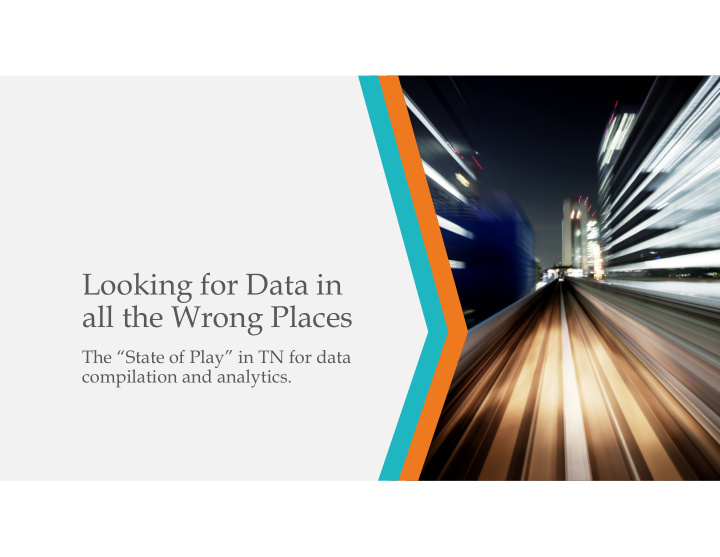



Looking for Data in all the Wrong Places The “State of Play” in TN for data compilation and analytics.
The Beginning What’s the Vision, and where is it coming from?
Who’s Vision is it really? The reality about transportation is that it's future-oriented. If we're planning for what we have, we're behind the curve. Anthony Foxx https://www.brainyquote.com/quotes/anthony_foxx_662999?src=t_transportation Some of the sources and champions who have influenced our vision: • Elected officials – Those who want to be “first.” The “Undiscovered Country.” • Visionary Transportation Professionals – • Dana Richardson – February 1998, City of Murfreesboro. • David Parker & Diane Davidson – April, 2002, City of Franklin. • Don Dahlinger – June, 2003, TDOT Region 3 • Vendors and Manufacturers – “We’ve got an app for that!”
The Basic Theory of Operation for a TMC The National ITS Architecture Communications Sausage Diagram. • Each black line represents data flow, typically two-way. Data aggregation takes place at: • • the “edge,” in field devices. • the “fog,” can be at the “head- end.” • the “cloud,” usually the “heavy analytics” is handled here. https://ops.fhwa.dot.gov/publications/telecomm_handbook/chapter3.htm
The Connection Point between all those modules? DATA • Traffic Signal Controllers • MMU • Vehicle Detection – • Video • Inductive Loop • Radar Wireless Pucks • • Ped Push Button • UPS/Power Condition Unit CCTV • • ETC.... And just as many data points from the vehicles.
It’s all about the Data Digesting the data, one byte at a time.
If it were “easy”…yada, yada, yada Estimates vary: • 4 TB(4,398,046,511,104 bytes or 4x1024 4 ) of data per hour/per vehicle according to Intel CEO Brian Krzanich He further indicates • that in 2020 a vehicle will generate and consume 40TB over https://www.networkworld.com/article/3147892/internet/one-autonomous-car-will-use-4000-gb-of- an 8 hour day. dataday.html
Data in Tennessee Today APPLES ORANGES We need the real-time data in Most of our current data High-resolution. sources are vendor or • JavaScript Object Notation manufacturer supplied as (JSON) “dashboard” applications. • eXtensible Markup Language These tend to be pre-formatted (XML) data extracted from the data These are embedded within the registers. They are not always application, often referred to as the back-end data. This is where consumable by other applications can be built to applications. consume your data sets.
In order to get to AV, we must first conquer CV This is a sample of the Automated Traffic Signal Performance Measures (ATSPM) from Nevada FAST program. It utilizes the Utah DOT free application for ATSPM. Activities such as this and the Signal Phasing and Timing (SPaT) data require the High- Resolutions data from an ATSPM capable controller and an API access to the back-end real-time data. http://challenger.nvfast.org/spm/
Middleware – The “Elmer’s Glue” TM of Data World 1.Message Oriented Middleware . This is a large category and includes asynchronous store and forward application messaging capabilities as well as integration brokers that perform message transformation and routing or even business process coordination. 2.Object Middleware . This category consists largely of Object Request Brokers that were mentioned on one of the earlier definitions. 3.RPC Middleware . This type of middleware provides for calling procedures on remote systems, hence the name Remote Procedure Call. Unlike message oriented middleware, RPC middleware represents synchronous interactions between systems and is commonly used within an application. 4.Database Middleware . Database middleware allows direct access to data structures and provides interaction directly with databases. There are database gateways and a variety of connectivity options. Extract, Transform, and Load (ETL) packages are included in this category. 5.Transaction Middleware . This category as used in the Middleware Resource Center includes traditional transaction processing monitors (TPM) and web application servers. One could make the case for splitting the category. 6.Portals . We include enterprise portal servers as middleware largely because they facilitate what we refer to as “front end” integration. They allow interaction between the user’s desktop and back end systems and services.
Middleware continued… Middleware is that piece of software that connects two or more software applications so that they can exchange data. Middleware is especially integral to modern information technology based on XML, Simple Object Access Protocol (SOAP), Web services, and service-oriented architecture. Middleware is essential to Enterprise Application Integration or EAI. NOTE: Expect contact from various software groups with solutions to your data integration projects.
The End No….not the end of the presentation…. And not the end of your program.
There isn’t an End… The Tangibles • Validation of your findings. • Reporting – monthly; quarterly; annually • Maintenance – Preventative and Responsive…forever. • Subscriptions – software, hardware, cloud services….forever • Training – New technologies emerging….forever The In-tangibles • What processes will need to be developed. Will they be Ad-hoc or formalized? • Who’s going to participate in the data sharing? Internal and External Stakeholders, Cross-jurisdictional MOU’s or MOA’s?
The Tennessee Local Agency Data Sharing Collaborative Brentwood Jackson Memphis Clarksville Johnson City Mt. Juliet Cleveland Kingsport Murfreesboro Chattanooga Knoxville Nashville Franklin Maryville Sevierville
The TN Local Agency Data Collaborative Focus Local Agencies typically share interests. These interests vary from those of state DOT’s as they are much more urban mobility focused. • Pedestrians • Bicycles • Parking • Transit • Traffic Signals The group intends to develop a set of standardized systems requirements and protocols that can be adopted statewide by the local agencies. These will be utilized in defining the operational parameters of your Middleware applications.
Closing Remarks and Questions Contact: Kevin Comstock Smart Cities Director City of Chattanooga, TN Department of Transportation kcomstock@chattanooga.gov 423.643.5959
Recommend
More recommend